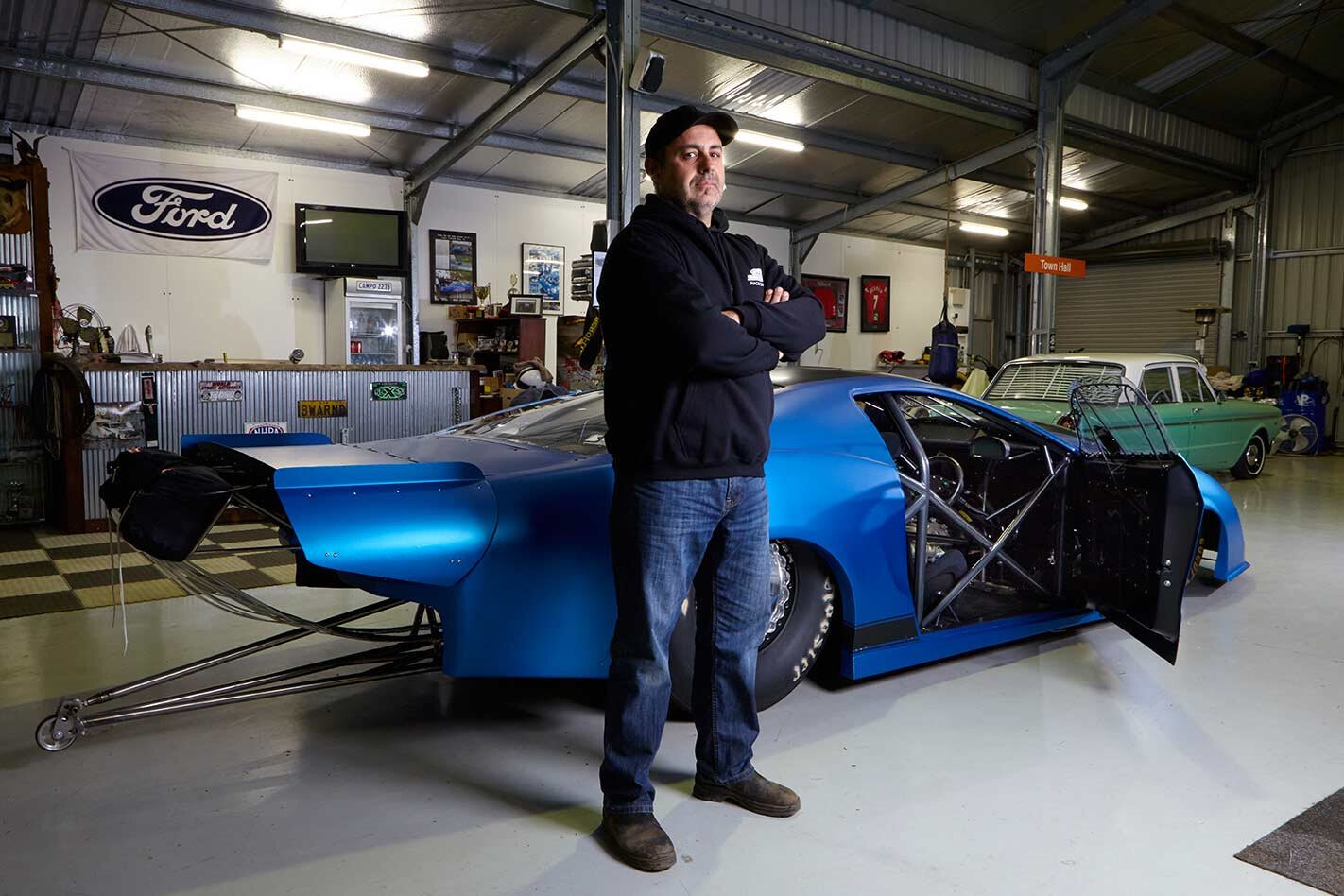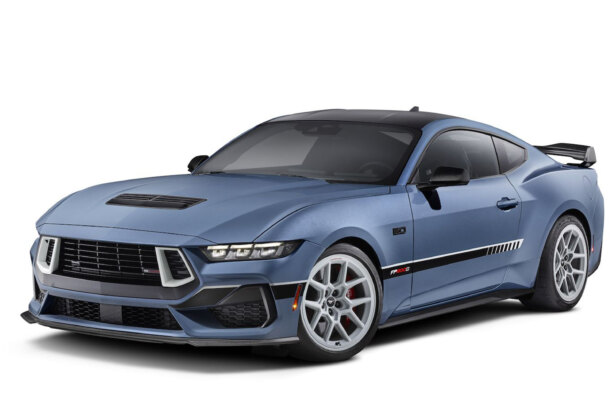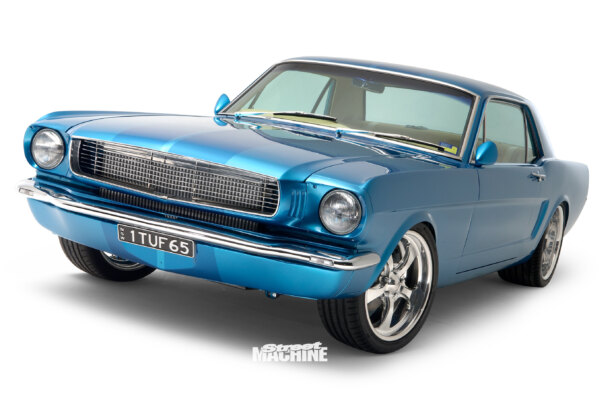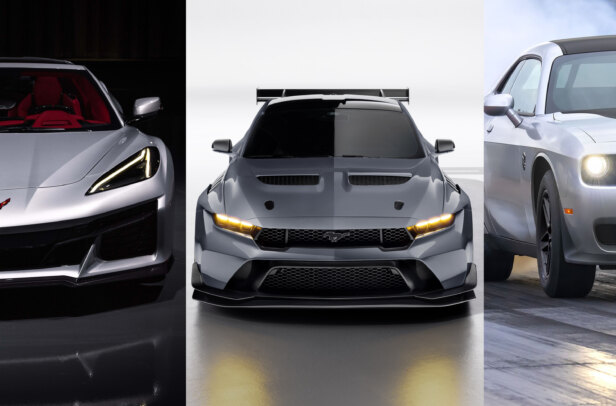This article on Rob’s Mustang was originally published in the October 2018 issue of Street Machine
WHEN Sydney’s Robert Campisi says he’s building a new car, you’d better grab a big bag of popcorn and get ready to watch records tumble!
In the world of turbo cars, nobody in Australia can hold a candle to the pioneering efforts of Campo. Among a number of very fast cars and numerous achievements to his name, Campo was the first to run a five-second pass in a turbo car in Australia.
Each of his Ford-powered creations have raised the bar, and his latest car – a tube-chassis wet dream of a Mustang built in Sydney and powered by a Moran Racing Engines hemi-headed big-block Ford, good for 5000hp – is about to put his previous milestones in the shade.
For the past few years Campo has been on the sidelines following the sale of his twin-turbo Moran-powered 2004 Mustang. At the time, the Pro Line 481X was considered the latest and greatest in the turbo evolution. It still is a great combination, but it wasn’t Campo’s weapon of choice then or now. Instead, he has stayed with the 670ci hemi-headed creation of American master engine builder and tuner, Mike Moran.
“The engine is a fantastic platform that is really built for strength and reliability,” Campo says. “Sure, the 481X is rated at 5000hp, but there is not one on the planet that is showing that power. I have a long history of success with Moran combinations and the engine really only needed a few upgrades to still make it cutting-edge today.”
The 670-cuber launched Rob into the five-second zone seven years ago, with a 5.95@260mph, and he was holding onto the donk just waiting for a set of turbos that would really bring it alive.
“Those previous Garrett 106mm Gen I turbos were a good deal, but when we ran them in the car we were always looking for more power. In the end we were running the motor with the wastegates shut and it would only make 44psi of boost,” Campo recalls. “When I sent the motor back to the USA, we dynoed it with those turbos on it in the same configuration, pretty much as we raced it last, and made around 4200hp.
“We knew there were some new-generation 106s coming, so we held off, and when they finally arrived those things set the internet on fire.”
The hemi-headed big-block Ford in Rob’s new Mustang was put together by Moran Racing Engines in the States, and now sports two new 106mm Garrett Gen II GTX5544R turbos, which helped the donk push out 5295hp on 70psi
With the new 106mm Gen II GTX5544R snails on board, the engine made 5295hp on 70psi boost. That’s impressive enough, but the torque figure is truly biblical – a whopping 3800ft-lb, nearly enough to spin the globe in the other direction!
To put that into perspective, the engine makes around the same as four pretty stout, blown and injected big-block Chevs all joined together.
The horsepower gain with those new turbos was just incredible and there is still more left in it, according to Campo. “We did close to 50 pulls on the dyno and it will get freshened by Mike Moran before being sent to Australia to be fitted in the car,” he says. “I would not be surprised if we could find another 500hp.”
The engine runs a billet block with a 5.3-inch bore spacing fitted with a Bryant crank with a 4.25-inch stroke and swinging seven-inch GRP alloy conrods with Diamond pistons, for a static compression ratio of 12.75:1.
The intake valve is a massive 55mm and the intake port flows 660cfm with one-inch of cam lift and 875lb of seat pressure with the valve closed. There are only four bolts per cylinder holding the head on, but the studs are 5/8-inch and torqued to 250ft-lb!
Even the oiling system is a work of art, with a CNC-machined, billet-aluminium oil pan with an integrated Dailey seven-stage pump. The block has a three-inch-raised cam tunnel and runs an 85mm cam with needle roller bearings.
The engine is fed though a billet intake manifold with 16 5000cc injectors and a belt-driven Waterman Big Bertha pump supplying 44 gallons of fuel per minute. A Pro Mag 44 lights the mix and the engine is controlled by a BigStuff3 ECU.
“I can’t see the point in going away from this ECU,” Campo says. “Ten years ago there were maybe four good ECUs; now they are pretty much all good, and I couldn’t see benefits in changing to a FuelTech or something like that when this system is what I know and it gets the job done. It has 500 channels so we will never run out of things to monitor. Ultimately, if you can’t tune, it won’t matter what ECU you run.”
Backing up the powerplant is a three-speed Liberty transmission with a ProTorque converter.
The engine is impressive, but so is the car that it’ll be thrown into. Campo put his trust in Sydney’s SCF Race Cars to build him a new and improved ’Stang. “When it came to instructions on building a new car, I told SCF’s Craig Burns: ‘I want the latest and greatest, do what you need to do, let’s build a better mousetrap,’” Campo says. “I left it to him; my only stipulation was that it had to be right-hand drive, as that’s what I am used to.”
Unlike the 2004 car, the new ride has gone to a 115-inch wheelbase rather than 109.
The body is one of Mike Moran’s 2014 carbonfibre Mustang moulds, with the rest of the car built from a combination of carbonfibre, chrome-moly, titanium and all the best stuff. “We are running a sheet-metal rear housing with a Tom’s Differentials 10-inch crown wheel with 40-spline Mark Williams axles, a 34×17 tyre and Menscer shocks front and rear,” Campo says.
“Building a car that is affordable to race was as much of a priority as anything,” he continues. “I’ve heard talk of some similar teams at this level spending almost $100K a year on diff centres as they need to change them every few passes.”
Asked about his ultimate goal with the car, Campo was reluctant to put a number on it. “Well, let’s just say that at one stage we were the quickest in the world, and I’d like to go back to that.”
Given the car is being built to at least run in the 5.30s, the 60-foot time will need to be better than .90sec, while the 660-foot time has to be in the mid-three-second zone!
“Horsepower is clearly an advantage, and we have a few more refinements to make before I’m happy with the package,” Campo says. “We are currently buzzing the motor to around 9000rpm, and it seems to be a little heavy on valve springs. Mike is making some changes at the moment to try and rectify that situation.
“I’d like to think the car will weigh in at around 2500lb,” he continues. “There’s a fair bit of weight in that motor, so we will see.”
With all things going well, the car should hit the track by the end of 2018.




Comments